Potatoes are a favorite food for many, but not everyone knows that this humble tuber is closely related to tomatoes and eggplants, sharing a family with some rather fearsome plants like deadly nightshade. They are all part of the Solanaceae family.
A Brief Genealogy of the Solanaceae Family
The Solanaceae family (scientific name: Solanaceae) is a family of flowering plants that includes many edible species as well as others that are considered toxic. This family is also commonly known as the nightshade family. The term Solanaceae derives from the genus Solanum, “shade-loving plants,” a large and diverse genus within the Solanaceae family. The Solanum genus includes three important plants that are familiar to humans: potatoes, tomatoes, and eggplants.
The origin of the name “shade-loving” is still unclear, but it may relate to the dark and mysterious past of the plants in this family.
The Solanaceae family consists of 98 genera and approximately 2,700 species, which vary widely in habitat, shape, and ecology. Many members of the Solanaceae family contain glycoalkaloid toxins, particularly the highly toxic species such as belladonna (also known as deadly nightshade, scientific name: Atropa belladonna). Both the leaves and stems of belladonna are poisonous.
However, there are a few nightshade species that are used as food. These include several nutritious fruits and vegetables that have been staple foods in many cultures for hundreds of years, such as potatoes, tomatoes, peppers, eggplants, tobacco, and tomatillos (also known as green tomatoes or Mexican tomatoes).
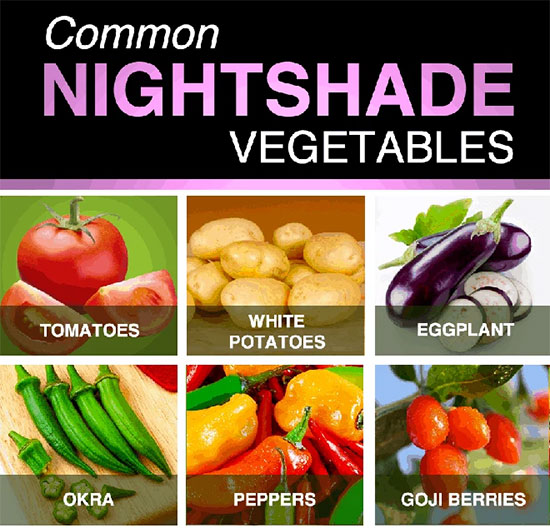
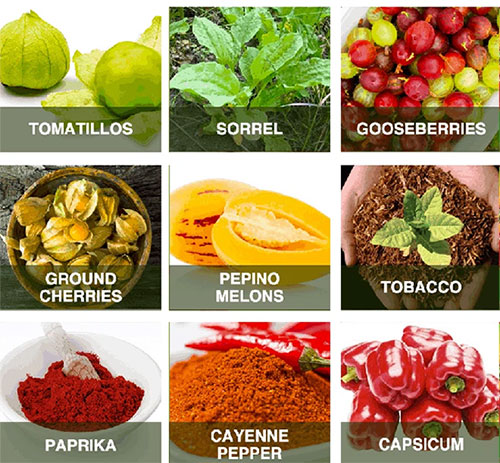
Some common vegetables belong to the Solanaceae family. (Image: DrJockers).
Other notable species in the Solanaceae family include Datura (Jimsonweed) and mandrake (also known as magical mandrake) – two toxic plants that were historically used as painkillers, as well as chili peppers (including paprika and chili pepper) and henbane.
Many herbs and spices also originate from the Solanaceae family, such as cayenne pepper, crushed red pepper, chili powder, and paprika.
Black and white pepper, which come from peppercorns, do not belong to the nightshade family.
Additionally, several common spices and food products use ingredients from nightshade vegetables, such as chili sauce, ketchup, marinara sauce, and salsa.
Botanically speaking, many nightshade plants that we consider vegetables are classified by scientists as fruits, such as tomatoes, eggplants, and peppers.
How Toxic is Solanine?
Solanine is one of the glycoalkaloid compounds found in nightshade plants. Solanine is bitter and toxic, serving as the primary toxin produced by potatoes when exposed to light; it acts as a defense mechanism against insects, bacteria, fungi, and hungry animals. In addition to potatoes, solanine is also found in several other nightshade plants, such as belladonna, black henbane (Hyoscyamus niger L.), tobacco (Nicotiana spp.), and edible plants like eggplants and tomatoes.
Although nightshade plants can be fatal if ingested, many fruits and vegetables within this plant classification (available at grocery stores) are actually safe to eat. This is because the solanine toxin levels decrease to non-toxic levels when the fruits and vegetables ripen.
However, most leaves or stems of plants in the Solanaceae family are toxic, including those of the edible plants mentioned in this article, such as potatoes, tomatoes, eggplants, and peppers… Therefore, you should avoid eating these parts unless you are certain of their uses or how to prepare them correctly.
One exception is chili leaves, which are often used by Vietnamese people to cook soups. Chili leaves are a medicinal herb in traditional medicine and are nutritious after cooking.
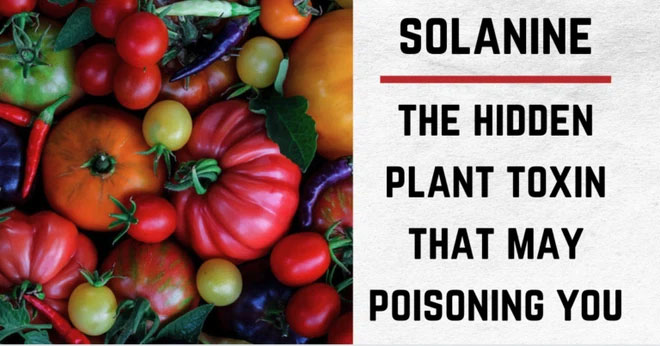
Solanine is a neurotoxin, and absorption of solanine in humans can lead to nausea, headaches, serious neurological issues, and even death if consumed in sufficient quantities.
According to Healthline, solanine works by inhibiting an enzyme involved in the breakdown of certain neurotransmitters. This compound also damages cell membranes and may negatively affect intestinal permeability.
How Much Solanine is Too Much?
Testing solanine on humans is unethical, making it difficult to determine exactly how much solanine will make you sick. This also depends on individual tolerance and body size.
Research on toxicology and reports of solanine poisoning will provide us with necessary information.
According to a 2004 study cited by Healthline, ingesting solanine at a level of 2 mg/kg of body weight is sufficient to produce symptoms of poisoning, and 1.25 mg/kg is enough to cause discomfort in some individuals. This means that a person weighing 50 kg could become ill after consuming 450 g of potatoes containing 20 mg of solanine per 100 g of potato.
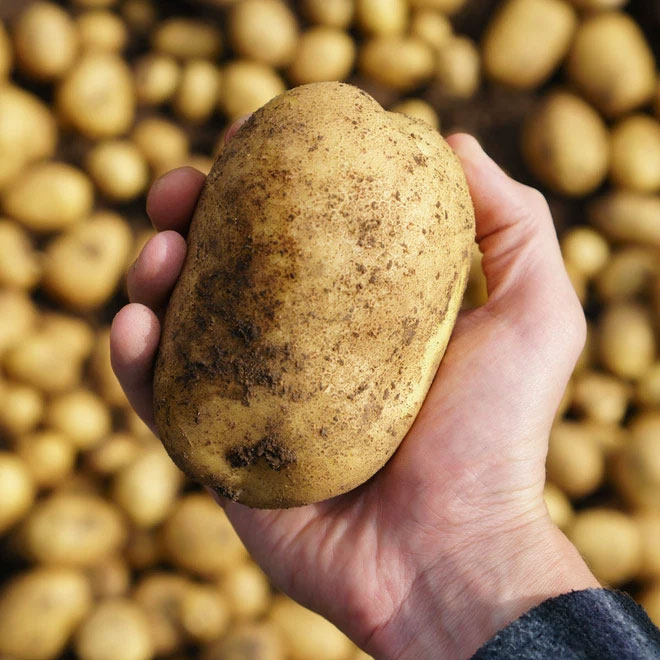
Symptoms of poisoning may occur when solanine is ingested at doses of 2-5 mg/kg of body weight. (Illustrative image).
If the person is lighter or a child, or if the potato accumulates solanine to a very high level, consuming even less potato can make them sick.
According to another study from 2006, symptoms of poisoning can occur when solanine is ingested at doses of 2-5 mg/kg of body weight, and death can occur at doses of 3-6 mg/kg of body weight.
Symptoms typically appear 8-12 hours after ingestion but can occur as quickly as 10 minutes after consuming foods high in solanine. Signs of solanine poisoning include nausea, vomiting, diarrhea, sweating, headaches, and stomach pain. Relatively mild symptoms like these will resolve within about 24 hours.
However, there are serious cases that can result in severe consequences such as paralysis, seizures, difficulty breathing, coma, and even death.
Solanine in Potatoes
Potatoes are the most important crop in the global diet, belonging to the Solanaceae family. Potatoes are one of the largest food crops in the world in terms of fresh yield, according to many years of statistics from the Food and Agriculture Organization of the United Nations (FAO). The global potato yield in 2019 was 370 million tons, ranking fourth after corn, wheat, and rice.
Potato plants contain several toxic glycoalkaloid compounds, primarily solanine and chaconine. Solanine in potatoes helps the plant defend against insect attacks; the leaves, flowers, sprouts, and green potatoes all contain solanine. Research shows that the highest levels of glycoalkaloid toxins in potatoes are found in the flowers and sprouts, with the lowest levels in the flesh of the tuber that we commonly eat (the potato tuber is actually a stem, not a fruit of the potato).
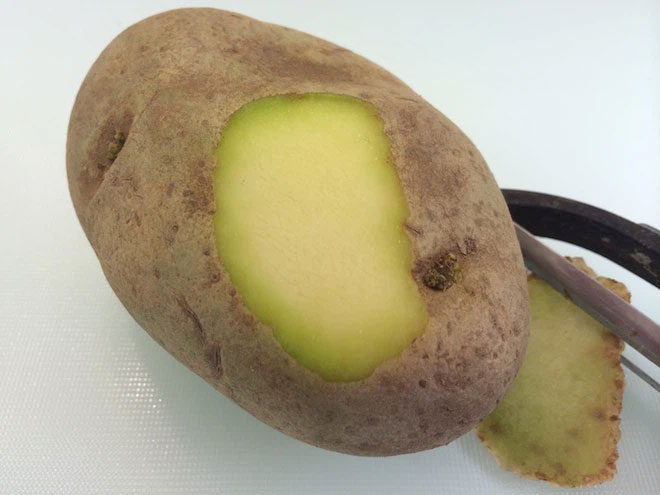
Green potatoes.
It is commonly recommended to store potatoes in a cool, dark place, away from light, because when exposed to light or high temperatures, potatoes will quickly sprout or turn green due to the presence of increased chlorophyll.
When exposed to light, the levels of the toxins solanine and chlorophyll—the compound that causes potatoes to turn green—will increase. Chlorophyll is harmless and is the compound that gives many plants their green color, but it also indicates the presence of the toxin solanine, as both compounds form at the same rate over time in potatoes.
Solanine in potatoes is not destroyed when the potatoes are cooked. Therefore, if you see potatoes sprouting or turning green, it is necessary to cut off the sprouts, eyes, green parts, and any bruises before cooking, as these are the areas where solanine is most concentrated.
According to Healthline, peeling and frying potatoes can also help reduce toxins.
However, it is still unclear whether these methods can consistently and adequately protect us from glycoalkaloid toxins. Therefore, the National Capital Poison Center (NCPC), a non-profit organization focused on poison prevention, recommends that it is best to discard potatoes when they have sprouted.
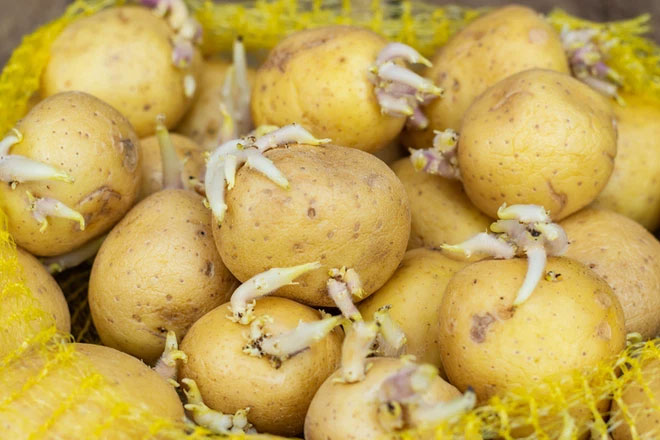
Sprouted potatoes.
The concentration of glycoalkaloids in wild potatoes is sufficient to cause poisoning in humans, but poisoning from cultivated potatoes is rare. When breeding commercial potato varieties, breeders eliminate plants with toxic traits and keep glycoalkaloid levels below 200 mg/kg. When potatoes turn green, their solanine content can reach up to 1,000 mg/kg. In normal potatoes, the solanine content is low, only accounting for 3.5% of the maximum toxin level mentioned above, ranging from 7-187 mg/kg. The glycoalkaloid content in the flesh of a normal potato is 12–20 mg/kg, while the glycoalkaloid content in the flesh of green potatoes is 250–280 mg/kg, and in the skin, it is 1,500-2,200 mg/kg.
According to the U.S. Food and Drug Administration (FDA) toxic plant database, the acceptable maximum level of glycoalkaloids is 20-25 mg/100g of fresh potatoes. Under current FDA regulations, 20 mg of solanine per 100g of potatoes (a small potato) means that 200 mg/kg of potatoes can render them inedible.




















































